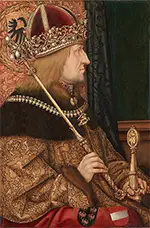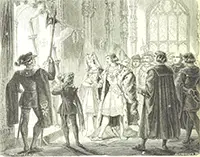Frederick III: King of Germany, Holy Roman Emperor
Frederick III was King of Germany for more than five decades in the 15th Century and was also Holy Roman Emperor for nearly that long. His rule set the stage for the preeminence of the House of Habsburg. 
He was born on Sept. 21, 1415, in Innsbruck, Tyrol. His father was Ernest, Duke of Austria, and his mother was Cymburgis of Masovia. Significantly, Ernest was of the Habsburg dynasty, which produced a long lines of kings and emperors. Frederick was 9 when his father died, and the boy took over as Duke of Inner Austria, which comprised the duchies of Carinithia, Carniola, Gorizia, and Styria. An uncle, also named Frederick, served as regent. When young Frederick was 20, in 1435, he won permission from Albert II, later the German king, to rule in his own right. By that time, however, his younger brother Albert (later known as Albert VI), just three years his junior, had made claims to Austrian rule as well. Albert II gained the German throne in 1438 but died only a year later. His son, Ladislaus, was next in line for the throne and Frederick acted as regent for the boy. He had laid claims to the thrones of Bohemia and Hungary but had achieved neither. His one hereditary crown was in Austria. Eventually, Frederick, who was actually a cousin of the recently deceased German king, was the choice of the German electors, who elected him King of the Romans (Germany) on Feb. 2, 1440, and he became King Frederick IV. Frederick made a pact with the Vatican in 1448, known as the Concordat of Vienna. This smoothed the way for him to be crowned Holy Roman Emperor, which he was, by Pope Nicholas V, on March 19, 1452. (He was crowned as the Emperor Frederick III, the first Habsburg to be so honored.) By that time, Frederick had met the woman who was to be his wife, Eleanor of Portugal, whose father was King Edward (Duarte) of Portugal. Frederick and Eleanor had five children, two of whom lived into adulthood: Maximilian (1459) and Kunigunde (1465). Frederick's brother Albert raised an army against him in 1462, but the younger brother's death the following year ended the uprising, which resulted not only from his brother's ambitions but also from a general discontent within German lands with Frederick's Austrian heritage. 
In 1477, Maximilian married Mary of Burgundy, whose father was Charles the Bold, duke of Burgundy (which at the time included Belgium and the Netherlands). The marriage united two large domains and paved the way for later Austrian success. As Frederick aged, and despite unsuccessful wars in Hungary, he turned to thoughts of succession. As had been done in previous centuries, he had his son, Maximilian, declared co-King of Germany; this occurred in 1486, just as Matthias I Corvinus of Hungary was taking over most of Austria. Maximilian led an army that eventually took it back, four years later. Frederick's health deteriorated sharply in 1493. He died on August 19 of that year, in Linz, after complications from surgery. His son was King Maximilian I. |
|
Social Studies for Kids
copyright 2002–2024
David White




